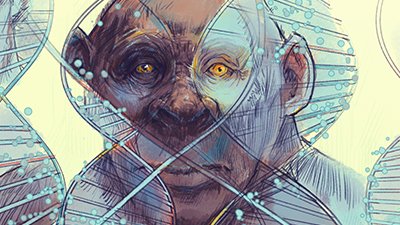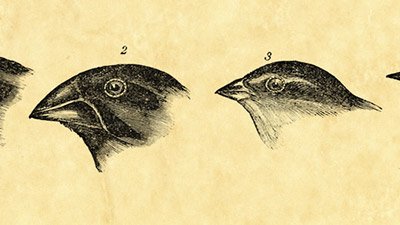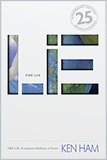
Frog that Lays Land and Water Eggs Seen as Evidence for Evolution
The hourglass treefrog from Panama is about to become an icon of evolution due to its strange egg-laying behavior.
News Source
- LiveScience: “Transitional Frog Lays Eggs on Water and Land”
The frog, Dendropsophus ebraccatus, is the first known vertebrate that can lay eggs both in water and on land—and thus helps evolutionists answer the question of how the first amphibians (in their minds) made the water-to-land transition.
When the eggs hatch, the tadpoles drop directly into the water.
Typically the frog lays its eggs on plants hanging over ponds. When the eggs hatch, the tadpoles drop directly into the water. Yet researches Justin Touchon and Karen Warkentin of Boston University discovered a pond in Panama that lacked a forest canopy, and thus the frogs had laid most of their eggs directly in water (but supported by aquatic vegetation). A few eggs were left out on leaves above the water, unprotected by forest, and therefore in dangerous direct sunlight.
The researchers also determined that genes weren’t controlling the egg-laying behavior. They built small ponds in an open field and a forest, and in the field pond, the frogs laid eggs in the water; in the forest pond, the eggs were on plants above the water as expected.
So how does this finding tie in with the grand story of evolution? Charles Choi of LiveScience explains:
Although humans did not evolve from frogs, our evolution does go back to other, albeit long extinct amphibians. Our remote ancestors might have evolved reproduction on land to escape aquatic predators or to cope with alterations in the environment just as these treefrogs do, improving their chances of surviving changes in habitat or climate.
The researchers already believed . . . that terrestrial egg-laying had evolved in frogs.
Interestingly, however, Touchon notes that “Terrestrial egg-laying has evolved many times in frogs, so there might be multiple transitional species capable of both aquatic and terrestrial breeding.” In other words, the researchers already believed, even before finding or observing these frogs, that terrestrial egg-laying had evolved in frogs; furthermore, the scientists’ experiment showed the egg-laying behavior was not determined by genetics. Rather, these frogs are simply “smart enough” to lay eggs where they will be most safe—like a bird building a nest in a safe tree nook. Touchon and Warkentin have done nothing to prove that this behavior evolved; that was the assumption they began with; their experiment did not address this assumption; and their conclusion, as reported by the media, is that this frog is evidence of the water-to-land transition in evolution! As with item #6 below, this is an incredible example of a vastly inflated evolutionary interpretation of the actual facts.
Creationists find this discovery fascinating, but the interpreted conclusion is very different. Terrestrial egg-laying didn’t evolve “so many times,” as Touchon says; instead, the original frog or frog-like kind God created (likely including toads and perhaps including other amphibians such as salamanders) had the ability to lay eggs in different locations based on the environmental context. And, we’d submit, this interpretation is at least as true to the facts (and much closer to reality) as the researchers’ claim!
This story brings us to other news, which broke late in the week: the finding of the “frogamander,” a supposed “missing link” between modern-day frogs and salamanders. The find was reported in Nature and is reported on by National Geographic News.1
Supposedly 290 million years old, the frogamander fossil was collected in Texas a decade ago, then “rediscovered” in the National Museum of Natural History in 2004. Comparative biologist Jason Anderson of the University of Calgary led the new analysis of the fossil, claiming he recognized the “froggy slamander-y sort of look” of the fossil— now dubbed Gerobatrachus hottoni.
The creature is said to fit a “noted gap” in the amphibian fossil record—one of those gaps the media never reports on until it’s filled! Anderson judges that the animal would have looked like a stubby-tailed salamander with froglike ears and that it “pretty convincingly settles the question [that the] frog and salamander shared origins from the same fossil group.”
The creature is said to fit a “noted gap” in the amphibian fossil record.
A couple of thoughts for creationists. First, although the find has been reported with typical evolutionary fanfare and certainty on the surface, that’s not to say everyone agrees with the complete analysis. For example, read what National Geographic News reported from the Field Museum’s John Bolt, a curator for fossil amphibians and reptiles:
Bolt, the Field Museum expert, cautioned that it is difficult to say for sure whether this creature was itself a common ancestor of the two modern groups, given that there is only one known specimen of Gerobatrachus, and an incomplete one at that.
“At this point I would say it is by no means certain that this is representative of a common ancestor to frogs and salamanders, although it might be,” Bolt said.
Bolt also says, intriguingly, “The most astonishing thing to me about this study is that this animal is far more froglike than I would ever have expected from its age. Nothing this nonprimitive has ever been described from this age. It's just amazing.” (Emphasis added.)
Our second thought is that it is possible that, assuming the incomplete fossil has been interpreted accurately and truly shares frog and salamander features (and such assumptions often fail to hold true), frogs and salamanders descended from the same amphibian kind—that is, selective pressures gradually exploited the genetic variation in an original amphibian kind, resulting in the two modern groupings. If not, it is possible God created an amphibian kind with features in common with both salamanders or frogs.
As always, though, Christians must separate the actual finding from the interpretation. There are several creation-based explanations for an incomplete fossil with salamander and frog features, but all too often, well-meaning Christians swallow the evolutionary propaganda whole, facts and worldview, without trusting God over man’s often-foolish speculation.
Further Reading
For More Information: Get Answers
Remember, if you see a news story that might merit some attention, let us know about it! (Note: if the story originates from the Associated Press, FOX News, MSNBC, the New York Times, or another major national media outlet, we will most likely have already heard about it.) And thanks to all of our readers who have submitted great news tips to us. If you didn’t catch all the latest News to Know, why not take a look to see what you’ve missed?
(Please note that links will take you directly to the source. Answers in Genesis is not responsible for content on the websites to which we refer. For more information, please see our Privacy Policy.)
Footnotes
- Anne Casselman, “‘Frog-amander’ Fossil May Be Amphibian Missing Link,” National Geographic News, May 21, 2008, http://news.nationalgeographic.com/news/2008/05/080521-frog-fossil.html.
Recommended Resources

Answers in Genesis is an apologetics ministry, dedicated to helping Christians defend their faith and proclaim the good news of Jesus Christ.
- Customer Service 800.778.3390
- © 2024 Answers in Genesis





